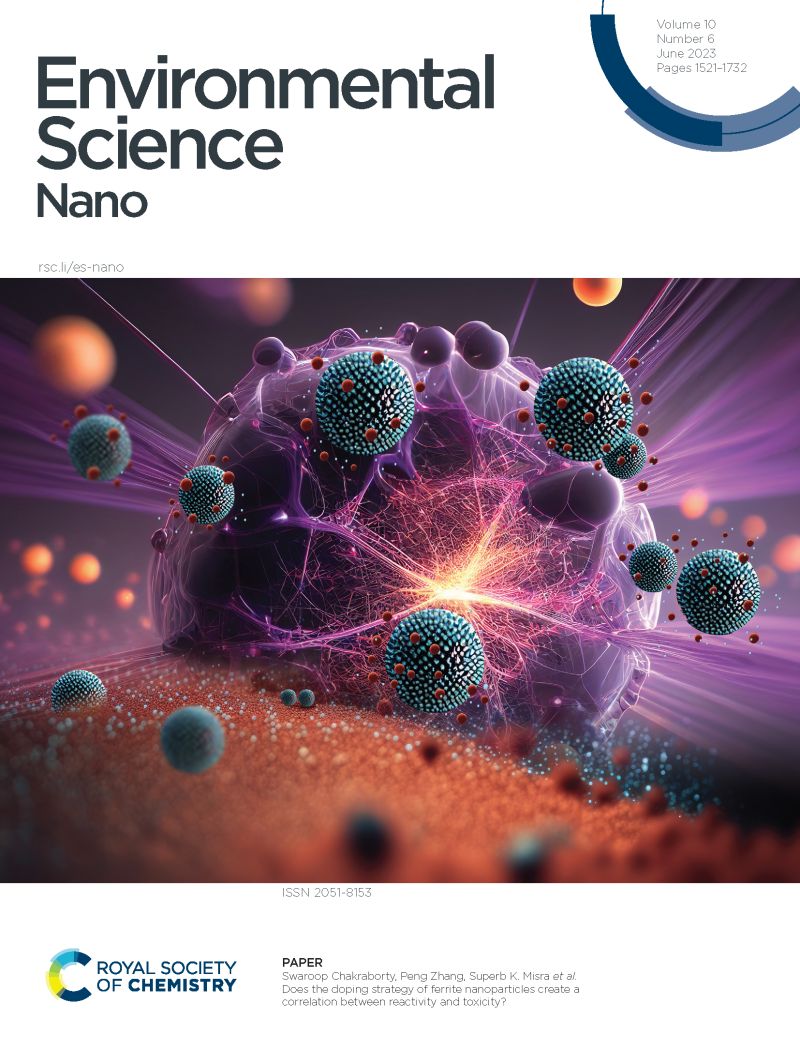羰基诱导CoxSy中Co(III)还原为Co(II),使硫酸盐自由基主导的过氧单硫酸盐活化
IF 5.1
2区 环境科学与生态学
Q1 CHEMISTRY, MULTIDISCIPLINARY
引用次数: 0
摘要
硫化钴(CoxSy)有望在高级氧化过程(AOPs)中激活过氧单硫酸根(PMS),但其应用面临着主要挑战,包括硫酸盐自由基(SO4•-)生成低,PMS分解效率低,以及抗生素去除的矿化效率有限。本研究通过配位羰基(C=O)与钴来稳定低价钴,并通过缺陷工程增强电子转移,从而解决了这些限制。合成了褐煤活化的焦炭负载的硫化钴(LAC@CoxSy-V),表现出几乎完全转化为低价钴(Co2+)和丰富的硫空位。与CoxSy/PMS体系相比,LAC@CoxSy-V/PMS体系对磺胺甲恶唑(SMX)的降解Kobs和矿化效率分别提高了18倍和2倍。机制研究表明,CoxSy在LAC表面的配合使钴-羰基配位,促进电子从电负性的C=O转移到Co3+,将其还原为Co2+。硫空位的引入进一步增加了低价钴的比例,促进了PMS活化生成SO4•-。这些自由基是主要的活性氧(ROS),而硫空位同时促进单线态氧(1O2)的产生,协同促进SMX的降解。通过基质干扰试验、循环稳定性评估和模拟医疗废水处理的连续流固定床反应器实验,验证了该系统的适用性。该研究为通过PMS-AOPs有效去除抗生素的缺陷和配体工程策略提供了有价值的见解。本文章由计算机程序翻译,如有差异,请以英文原文为准。
Carbonyl-Induced Reduction from Co(III) to Co(II) in CoxSy Enables Sulfate Radical-Dominated Peroxymonosulfate Activation
Cobalt sulfide (CoxSy) shows promise for activating peroxymonosulfate (PMS) in advanced oxidation processes (AOPs), but its application faces key challenges, including low sulfate radical (SO4•–) generation, inefficient PMS decomposition, and limited mineralization efficiency for antibiotic removal. This study addresses these limitations by coordinating carbonyl groups (C=O) with cobalt to stabilize low-valence cobalt species and enhance electron transfer through defect engineering. A lignite-activated coke-supported cobalt sulfide (LAC@CoxSy-V) was synthesized, exhibiting a nearly complete conversion to low-valence cobalt (Co2+) and abundant sulfur vacancies. Compared to CoxSy/PMS system, the Kobs of sulfamethoxazole (SMX) degradation and the mineralization efficiency of SMX in the LAC@CoxSy-V/PMS system are 18-fold and 2-fold higher, respectively. Mechanistic studies revealed that CoxSy complexed on the LAC surface enables cobalt-carbonyl coordination, facilitating electron transfer from the electronegative C=O to Co3+, reducing it to Co2+. The introduction of sulfur vacancies further increases the proportion of low-valence cobalt, promoting PMS activation to generate SO4•–. These radicals act as the primary reactive oxygen species (ROS), while sulfur vacancies simultaneously promote singlet oxygen (1O2) generation, synergistically enhancing SMX degradation. The applicability of this system was validated under various conditions, including matrix interference tests, cyclic stability assessment, and continuous-flow fixed-bed reactor experiments simulating medical wastewater treatment. This study provides valuable insight into defect and ligand engineering strategies for efficient antibiotic removal via PMS-AOPs.
求助全文
通过发布文献求助,成功后即可免费获取论文全文。
去求助
来源期刊

Environmental Science: Nano
CHEMISTRY, MULTIDISCIPLINARY-ENVIRONMENTAL SCIENCES
CiteScore
12.20
自引率
5.50%
发文量
290
审稿时长
2.1 months
期刊介绍:
Environmental Science: Nano serves as a comprehensive and high-impact peer-reviewed source of information on the design and demonstration of engineered nanomaterials for environment-based applications. It also covers the interactions between engineered, natural, and incidental nanomaterials with biological and environmental systems. This scope includes, but is not limited to, the following topic areas:
Novel nanomaterial-based applications for water, air, soil, food, and energy sustainability
Nanomaterial interactions with biological systems and nanotoxicology
Environmental fate, reactivity, and transformations of nanoscale materials
Nanoscale processes in the environment
Sustainable nanotechnology including rational nanomaterial design, life cycle assessment, risk/benefit analysis
 求助内容:
求助内容: 应助结果提醒方式:
应助结果提醒方式:


